
Rolls-Royce Owners' Club
of Australia Library
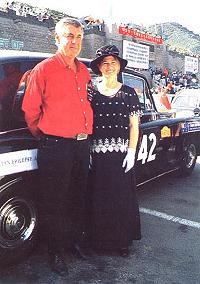
The Peking to Paris Motor Challenge
Leg One - Beijing to Kathmandu
By John Matheson, 1998
After two years of preparation we flew into Beijing on August
30th 1997 to meet the other contestants and the rally
organisers and to pick up the car. We bussed down to Xingang
on Wednesday to get the cars out of the containers. Here
bureaucratically everything worked very well and the cars
came out, dusty but undamaged. We then fuelledup the
vehicles and headed out in convoy for Beijing. With our
Chinese number plates and drivers' licences we were able to
head up to Beijing. Two pre-war Fords never even made it
to Beijing, developing terminal engine problems coming out
of the port. There we were able to prepare the cars properly
and pack them. On our last night in Beijing we met the
Australian Ambassador Mr Rick Smith who takes a great
interest in the old cars and the next morning saw us off as well
as entertaining the three Australian crews at the Embassy.
On a hot, sunny day the convoy eventually headed out of
Beijing on September
6 for the Great Wall. The first two days were more or
less convoy days with the Chinese police being reluctant to leave
us alone. Heading north west from Beijing into inner Mongolia,
the police presence was very heavy. Even in the
country areas there was at least one policeman every kilometre
and in some areas the policemen were 10 metres apart.
The route followed the Yellow River. The first night was spent
at Baotou, and the second night in Yinchuan. These
were fairly easy runs of about 500 to 600 km. The third day
took us into Lanzhou which is very much an industrial
area. Lanzhou itself is in a Muslim province in the Ningxia
Autonomous Region. We had a rest day in Lanzhou
spending most of the time attending to the cars and then
headed out on Thursday September 11 to head for Koko Nor.
Lord Montagu's 1914 Prince Edward Vauxhall had broken down
shortly after the start of the event when its fan came
loose and cut the radiator. He and his mechanic tried
valiantly to keep going but eventually they had to give up. The car
and the mechanic went back to Beijing. Lord Montagu
continued the trip joining us in Lanzhou and travelling with us
until we
broke down in Tibet. He was to rejoin us on some other
legs of the trip. He eventually arrived in Paris after travelling in
some 17 different cars.
Koko Nor is a lovely lake nestling in a rather barren landscape
of dusty hills on the edge of the Tibetan Plateau.
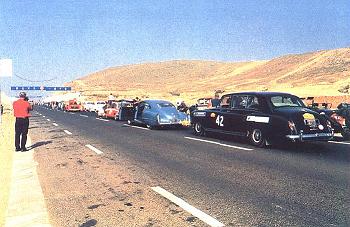 The following day we headed out to Golmund, a town originally
part of Tibet but now in a separate province. Golmund
itself is a bit of a frontier town and the facilities were now
starting to deteriorate. Nevertheless the running was easy but
some cars were starting to break down as we were continually climbing higher.
The following day we headed out to Golmund, a town originally
part of Tibet but now in a separate province. Golmund
itself is a bit of a frontier town and the facilities were now
starting to deteriorate. Nevertheless the running was easy but
some cars were starting to break down as we were continually climbing higher.
A lovely pre-war Stutz had terminal electrical problems and
several other cars also pulled out reducing the fleet by nine
cars. The driver of the reproduction La France had to pull out.
It was starting to get high and cold and at the campsite at
Koko Nor he developed hypothermia and went on to get pneumonia
forcing the withdrawal of the car, although it was
to re-join the fleet in Istanbul.
Once we left Golmund we climbed up on to the Tibetan Plateau.
This was a long, hard day
on indifferent roads. Light
snow had been falling and the roads were quite
wet. There were many bypass sections due to incompleted bridges
and a lot of offroad excursions
through deeply rutted, muddy areas which had been cut up by
trucks. All of the cars had trouble
with stranding under these circumstances.
The climb brought us from the relatively low attitudes of Golmund at about 2,500 metres up to
5,200 metres - about as high as any road goes in the world. Not surprisingly this day was
associated with the development of some mountain sickness but it was less than I had
anticipated. Most people had taken Diamox and this had ameliorated the effects of altitude.
However some people had to be put on oxygen and Prince Idriss Shah from Malaysia had quite a
hard time accommodating to these high altitudes. Eventually everybody did acclimatise.
The Tibetan Plateau is a grim place. It depends on the
spring melt to provide a pasture for grazing
sheep. Nothing grows up there and there are no trees,
only barren grasslands. One of the few
places that has been affected by the greenhouse effect
has been Tibet because there has been a fall
in precipitation leading to poor pastures. The Tibetan
herdsmen are starting to struggle because of
lack of adequate pastures for their sheep and overgrazing.
There is no fuel other than sheep dung
and no source of heating in winter in this harsh and barren environment.
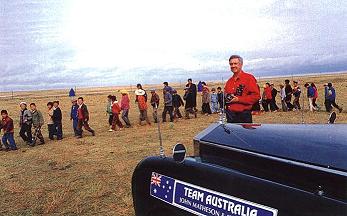 We were heading for an army compound at Tuotuoheyan
where we were to camp for the night. It
was here that the Phantom V ran into troubles. At
one bypass for a partly constructed bridge the
washouts were particularly severe. We had picked a
path through this, keeping our wheels up on
the edge of the truck ruts. Unfortunately at this
moment the driver of a Chinese 4-wheel drive
vehicle chose to come down and watch the sport. He
pulled his vehicle up in front of us, forcing
us down into a hole. This stranded the Phantom V
on its differential with the back wheels in the
air. Without any traction to move we needed assistance.
An inexperienced driver of another 4-wheel
drive came around in front of us and attached a
rigid tow-rope. Hoping for a gentle tow we
were disappointed to find that he rushed out at speed
and dragged us out on the differential as
fast as he could. This resulted in the after-market
offside rear spring breaking its main leaf
right forward at the front shackle. We were able to
drive back onto the main road. By this time the
axle was starting to move backwards and we could proceed no further.
We were heading for an army compound at Tuotuoheyan
where we were to camp for the night. It
was here that the Phantom V ran into troubles. At
one bypass for a partly constructed bridge the
washouts were particularly severe. We had picked a
path through this, keeping our wheels up on
the edge of the truck ruts. Unfortunately at this
moment the driver of a Chinese 4-wheel drive
vehicle chose to come down and watch the sport. He
pulled his vehicle up in front of us, forcing
us down into a hole. This stranded the Phantom V
on its differential with the back wheels in the
air. Without any traction to move we needed assistance.
An inexperienced driver of another 4-wheel
drive came around in front of us and attached a
rigid tow-rope. Hoping for a gentle tow we
were disappointed to find that he rushed out at speed
and dragged us out on the differential as
fast as he could. This resulted in the after-market
offside rear spring breaking its main leaf
right forward at the front shackle. We were able to
drive back onto the main road. By this time the
axle was starting to move backwards and we could proceed no further.
We had travelled beyond the first pass of 5,200
metres and we were only down a short distance from this
on the Tibetan Plateau. One cannot think of a worse place
to be stranded with a broken
spring than at 5,000 metres up in the Tibetan plateau with
no towns or civilisation anywhere in
sight. There were two sweep vehicles with mechanics on them
accompanying the fleet but both
these vehicles went past us without stopping, saying that
they would leave us to the China
International Sports Travel Company.
The China International Sports Travel Company (CISTC) was
following us round in 4-wheel
drive vehicles. They were supposed to be organising the
tour and assisting with the evacuation of break
downs. In fact, they did nothing. They even refused to tow
contestants when they needed a tow.
They provided no service but they certainly did their best
to collect money. The Lonely Planet
Guide to China describes the CISTC as having a reputation
for overcharging and providing a poor
service and I must say that is an understatement.
They pulled up to tell us that they would try to get a
truck for us but that would probably take
two days. We were then left to our devices on the Tibetan
plateau. That night in the campsite.
which was down in a valley, the temperatures reached
-8 °C. We were up in the windswept
plateau and the temperatures were clearly a lot lower than
that. There was some snow that night
and a very very heavy hoar frost. Fortunately we had brought a quilted car cover
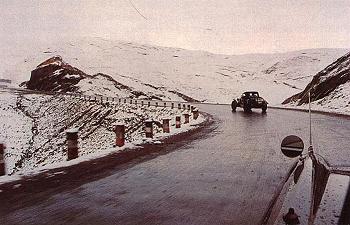 with us and with this over the Phantom V and our sleeping
bags inside we were actually quite
comfortable for the night and did not get cold.
with us and with this over the Phantom V and our sleeping
bags inside we were actually quite
comfortable for the night and did not get cold.
About 3 o'clock in the morning the CISTC turned up
with two so-called mechanics from
Tuotuoheyan. They said they had instructions to take
our spring off and get it repaired. I pointed
out to them that they could not take the spring off
and they certainly could not get it repaired.
There was no method of detaching the front shackle
that had been welded on. However I could not
stop them. It would have taken me to physically
prevent them from doing this, something you
really cannot do with the Chinese. These two
mechanics mucked around for a couple of hours,
dismantled the spring, realised they could
not get it off and could not re-assemble it.
They left us then with the spring partly detached
and in a worse state than we were in
before we had broken the spring. They insisted
on charging us quite a lot of money for this
ridiculous service although the local Tibetan
mechanics did not want to take the money. They then
disappeared into the night.
We were stranded for more than 24 hours until
eventually, late the next day, a truck turned up. This
truck had a tray which was barely 6 metres
long and had no means to load or unload the car. The
CISTC people then turned round and said to us
that it would cost $US3,000 to put the car on the
truck. We could take it or leave it. When I
complained that it was too much money they turned
round to walk away. So much for their so-called
contract to get the cars out. We were forced to
accept this. We eventually got the Phantom V on
the back of this truck by finding a washout on
the side of the road and building a ramp. The
Phantom V was then winched onto the back of the
truck from a 4-wheel drive. The winch was fed
forward round the cabin of the truck and pulled us
on while I steered the Phantom onto the tray.
Them was no method of tying the car down and no
method of locating it on the back of the truck.
The sides were put up. Fortunately the vehicle being
long was solidly jammed between the two ends
of the truck so that the tray wedged the Phantom
in. There was no room in the truck for us to travel
and we were forced to travel inside the Phantom
V on the back of the truck - a rather sea-sickly ride.
We then proceeded in this manner for the next
19 hours until we got into Lhasa. We know that the
truckies were paid approximately $US200 for
the trip into Lhasa for which we had to pay
$US3,000 - the rest of it being pocketed by the
CISTC.
There is not a bit of timber, let alone any grass,
on the Tibetan plateau, and we had no way of
locating the axle and preventing the spring damaging
underneath the car. In the ride to Lhasa we
sustained horrific damage from the broken spring.
Some of the other cars that were trucked on this
section sustained a lot of bodywork damage
because the vehicles were unsecured in the backs of
the trucks and just slammed from side to side
inside the trucks. Fortunately that did not happen to us.
The first death associated with the trip occurred
on the Tibetan Plateau. One of the locals had
stepped behind a bus and was clipped by one of the
Mercedes Benz cars. These people were
responsible drivers and were not speeding and the
accident was simply unfortunate and one of
those events which occurs in street crowds. The
Tibetan sustained a broken hip. In our societies
this would not be a major problem but in Tibet
it is. He was simply put in a hospital bed and
offered no treatment and eventually died of shock
about four days later. The inevitable outcome of
untreated fractured hips. We passed the Mercedes
with the crew and one of the Rally officials
being detained on the side of the road under
apparent house arrest. They were surrounded by a
group of Tibetans, women on one side and men
on the other. One of the men was carrying a
rather crude smallbore rifle. The matter was
eventually settled by handing
over a bribe to the Chinese Police.
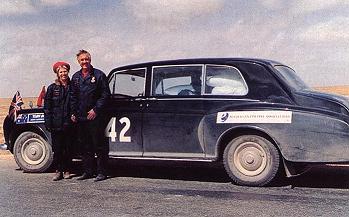
When we got to Lhasa there was no method of unloading
the trucks. They wanted to put rope
slings through the windows and lift it off You can
imagine the damage that would have caused to
the bodywork. When we said we would not allow
this they suggested that we put two steel 'I'
beams through the windows of the car and lift
it up in that manner. Naturally. we again refused.
Finally we found a bank new the Brahmaputra
River. We were then able to build up some stones
on this bank to made a ramp and to tow the Phantom
V off. This resulted in some damage to the
offside rear wing as it dragged along the ground.
We then towed the Phantom a short distance
down to the hotel and had a look at the damage.
The damage we had sustained on the truck was
quite horrendous. The rear spring had rocked
backwards and forwards. The front of the
spring had penetrated through under the seat,
cut the wiring loom, damaged the main battery
lead and penetrated through the air conditioning and
heating unit in the back of the car. This resulted
in coolant loss as well as loss of electricity.
Fortunately I had disconnected all the batteries
so we did not have a fire. The spring had also split
open the petrol tank. So we had multiple systems
failure with fuel loss, coolant loss, electrical
system loss and a broken spring.
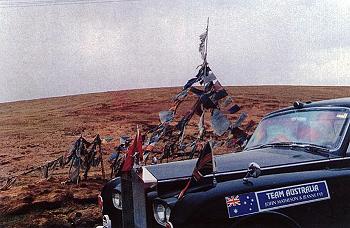 We took the car down to the local Toyota dealer's yard
in Lhasa He had sane pits them but few
facilities. They assured us they could fix the problem.
I went down the next day to find that the
car had been reassembled on its springs. When I had
a look they had merely brazed up the front of
the spring and put a welded spring back on the car
and had not built a new one. An electrician had
joined up the sections of the loom that had been
cut but had made no attempt to deal with the bare
wires and the main battery lead. Coolant continued
to leak from the car as did petrol.
We took the car down to the local Toyota dealer's yard
in Lhasa He had sane pits them but few
facilities. They assured us they could fix the problem.
I went down the next day to find that the
car had been reassembled on its springs. When I had
a look they had merely brazed up the front of
the spring and put a welded spring back on the car
and had not built a new one. An electrician had
joined up the sections of the loom that had been
cut but had made no attempt to deal with the bare
wires and the main battery lead. Coolant continued
to leak from the car as did petrol.
Surveying the sorry scene we really could not see
how we could go on. We attempted to get a
truck to see if they could take us through to the
Nepalese border but the CISTC said this was not
possible and that we would have to truck the
vehicle back to Beijing. They really had dollar signs
in their eyes at this stage and were starting to
talk about it costing $US21,000 to get the vehicle
back to Beijing! Unable to get a truck to go on
we had given up and had decided that we would fly
on to Kathmandu and send the car back to Beijing.
High altitudes are a strange thing. When you are
sitting up at 5,000 metres trying to do physical
work like jacking a car up it is very exhausting.
I could only manage seven turns of the jack handle
before I would need to take some oxygen and everything
became in slow motion. Thinking also
became slow motion and I found it very very difficult
to sequence my thoughts. I really could not
see any way out of the situation.
The following morning I went out of the hotel to see
the fleet departing but left behind was one
vehicle. This was a rather wonderful 1927 Mercedes
630K open tourer owned by Etienne Veen
who had come from Holland together with Robert
Dean his English mechanic. They could not
proceed because they had burnt out all their magnetos.
A warning for those of us with magneto
ignition cars who might want to go on long trips.
He had spare magnetos with him but they had
been wound in the original manner using shellac. With
long hot days of driving the shellac had
simply melted in thew magnetos leaving him without
ignition. The car could not continue with coil
alone as it would not develop any power especially
at these altitudes. Etienne had decided that
they were going to go on and that he was going to
truck his car through to Nepal as far as he could
and he himself would fly on to Kathmandu to arrange
mechanical workshops and spare parts. He
left Robert to accompany the car to Kathmandu.
Jeanne and I met up with him and decided we
would go on too. Etienne had gone to
the Tibetans and had managed to get trucks
from the Tibetans at a fraction of the cost that the CISTC
people charged. I approached them and we made
an arrangement to truck on with these vehicles.
At this stage the CISTC found out what was
going on as Jeanne and I had cancelled our
arrangements to truck back to Beijing. I was
to go with the truck with the Phantom V while Jeanne
and Etienne would fly to Kathmandu to make
arrangements for trucks to meet us at the other side
and to have workshops available.
Mr Ma from CISTC then intervened and tried to get
our vehicles unloaded He wanted the money
to get them back to Beijing and he also wanted
his cut from the Tibetans. He told them that they
were undercharging us and that they would have
to offload the cars. We refused to offload the cars
and at that stage the driven went on strike for
12 hours and would not move the cars overnight.
However we persisted, refusing to take the vehicles
off and finally they consented to go on. We
travelled on with contracts saying they would
take us down to die border town of Xhangmu. They
said in no man's land them were facilities for
loading and unloading the vehicles. This was not to be
the case. They knew perfectly well that they
could not get down there because of the washouts on
the road. We headed out and decided we would
travel overnight and get to the top of the
Friendship Pass as soon as possible in order
to try and avoid Mr Ma and his attempts to get us
off our vehicles. We had the two trucks and
three drivers with us and we went on through into the
night. But at
 10 o'clock that night climbing back onto the
Himalayas and getting back up to high altitudes things
started to go wrong. One of the vehicles developed
two punctures in quick succession. The
Tibetans were absolutely exhausted changing these
tyres. They just simply could not go on. We
pulled into a small village where we stayed in
a mud hut for the night. It was a dirt-floored room
but it was quite comfortable with five reasonably
comfortable beds in it and we slept well that
night.
10 o'clock that night climbing back onto the
Himalayas and getting back up to high altitudes things
started to go wrong. One of the vehicles developed
two punctures in quick succession. The
Tibetans were absolutely exhausted changing these
tyres. They just simply could not go on. We
pulled into a small village where we stayed in
a mud hut for the night. It was a dirt-floored room
but it was quite comfortable with five reasonably
comfortable beds in it and we slept well that
night.
The next morning the appalling Mr Ma from CISTC
caught up with us. He sat and talked to the
drivers for a long period of time and again tried
to get the drivers to go back. We held out and
refused. One unfortunate effect of the night
driving was that we went past Mt Everest at night
time so that I have travelled over the top of the
world without actually seeing Mt Everest.
Nevertheless we went on until we reached the next
town, a little border town called Nyalam On
the way through my driver had developed mountain
sickness. Indeed it is the locals who change
altitude that get more trouble with mountain
sickness than some of the visitors. I fed him Diamox
and managed to keep him going. At Nyalam Mr
Ma again intervened to try to stop the vehicles
and after a row they continued on. We drove
on to the top of the Friendship Pass to a place called
Choksom. Choksom has a hotel but it had not
been inhabited for six years. We caught up with the
rest of the fleet at Choksom and stayed the
night in this hotel. At this stage the drivers were
refusing to go on saying they could not get
past the washouts. The reality of the situation was
that the drivers
were terrified and indeed I do not blame them.
The road was appalling and not really passable for
trucks.
The following morning reluctantly Robert Dean and
myself unloaded the Phantom V and the
Mercedes 630K, again using banks on the road to
push the cars out of the trucks. The Mercedes
could not go at all but at this stage the Phantom
V was mobile. I had bypassed the coolant system
underneath the car and puttied up the fuel tank.
I had also wrapped electric tape around the main
battery lead so it was working although it was
still damaged. Thus we had electricity. We had
some fuel ability and the coolant system was
secured We then proceeded to head down after the
rest of the fleet, down the Friendship Pass
with the Mercedes being towed when it had to be, and
free-wheeling the rest of the time. There was a
Phantom I on the trip which had also had
problems. Its electrical loom had caught fire-
and burnt out and he was also travelling down the
Friendship Pass without power. Andrew Snelling,
the mechanic from the Australian Wolseley
team, accompanied me for the first part of the
trip as we headed off down the Pass. Travelling on
a welded spring on what was the worst road in
the world that I have ever been on, was quite an
experience. I drove down at an average speed of
2 kilometres an hour making sure at no time did I
bounce the rear spring. The latter part I did
entirely on my own as Andrew had to leave.
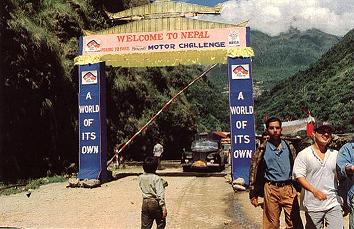 The Mercedes was actually able to get power half way
down by using a second coil to bypass
the magneto and managed to get enough power to ran. There were
landslides and washouts on this goat track down
the Himalayas. This track in a very short
distance goes from 5,200 metres down to 3,000
metres. At one stage we drove past an overhang
on the road. I kept the side of the Phantom as
close to the rock as I could on the inside of the road
and on looking out the window on my side I could
not see the road at all, only down 1,000 metres
into a gorge. There were rivers going down onto
the road forming waterfalls and at times the rivers
had used the road as a watercourse. On at least
two places I had to get out of the car and rebuild
roads down through these river washouts so that
I could drive across them. The hairpin bends
were such that you had to back and shuffle to
get around them; I could not take them in one
swing. The two vehicles that were free-wheeling
had to be towed up the hills on the hairpin bends
in order to get round them. I used fuel in the
auxiliary fuel tank letting only small amounts of it
into the ruptured main fuel tank so that I would
not waste fuel as I went down the pass. I
managed to get to the bottom of the pass without
breaking the spring.
The Mercedes was actually able to get power half way
down by using a second coil to bypass
the magneto and managed to get enough power to ran. There were
landslides and washouts on this goat track down
the Himalayas. This track in a very short
distance goes from 5,200 metres down to 3,000
metres. At one stage we drove past an overhang
on the road. I kept the side of the Phantom as
close to the rock as I could on the inside of the road
and on looking out the window on my side I could
not see the road at all, only down 1,000 metres
into a gorge. There were rivers going down onto
the road forming waterfalls and at times the rivers
had used the road as a watercourse. On at least
two places I had to get out of the car and rebuild
roads down through these river washouts so that
I could drive across them. The hairpin bends
were such that you had to back and shuffle to
get around them; I could not take them in one
swing. The two vehicles that were free-wheeling
had to be towed up the hills on the hairpin bends
in order to get round them. I used fuel in the
auxiliary fuel tank letting only small amounts of it
into the ruptured main fuel tank so that I would
not waste fuel as I went down the pass. I
managed to get to the bottom of the pass without
breaking the spring.
Jeanne had flown on and picked up a truck to meet
us at the bottom of the pass. After clearing
Chinese customs we had a look at the truck and
it was too small to take the Phantom, forcing
me to drive the rest of the way into Kathmandu.
On the way in we ran out of fuel. All the fuel
stations there only have diesel and kerosene
and no petrol. We eventually managed to get in by
buying seven 1-litre bottles of adulterated
fuel and putting them in the tank to keep us
going. This consisted of 70 octane petrol
adulterated with diesel and kerosene but the car kept
going albeit pinging a bit. We eventually arrived in Kathmandu.
Apart from the broken spring, the trip across
China had been relatively trouble free. The
reconditioned S.U. fuel pump packed up after
two days into China but I had a spare (non-S.U.)
pump with me which never gave any trouble.
The variation in the different types of fuel we were
using in the high altitudes was handled well
by the twin S.U. carburetters and only required me to
adjust the mixture from time to time to cater
for the quality of the fuel and the altitude. The car
lost a lot of power on the hill climbs but
never stopped and handled the conditions quite well.
Previously: Preparing for the Journey
Next Leg
RROC(A) Online Library
RROC(A) Main Page
 The following day we headed out to Golmund, a town originally
part of Tibet but now in a separate province. Golmund
itself is a bit of a frontier town and the facilities were now
starting to deteriorate. Nevertheless the running was easy but
some cars were starting to break down as we were continually climbing higher.
The following day we headed out to Golmund, a town originally
part of Tibet but now in a separate province. Golmund
itself is a bit of a frontier town and the facilities were now
starting to deteriorate. Nevertheless the running was easy but
some cars were starting to break down as we were continually climbing higher.


 We were heading for an army compound at Tuotuoheyan
where we were to camp for the night. It
was here that the Phantom V ran into troubles. At
one bypass for a partly constructed bridge the
washouts were particularly severe. We had picked a
path through this, keeping our wheels up on
the edge of the truck ruts. Unfortunately at this
moment the driver of a Chinese 4-wheel drive
vehicle chose to come down and watch the sport. He
pulled his vehicle up in front of us, forcing
us down into a hole. This stranded the Phantom V
on its differential with the back wheels in the
air. Without any traction to move we needed assistance.
An inexperienced driver of another 4-wheel
drive came around in front of us and attached a
rigid tow-rope. Hoping for a gentle tow we
were disappointed to find that he rushed out at speed
and dragged us out on the differential as
fast as he could. This resulted in the after-market
offside rear spring breaking its main leaf
right forward at the front shackle. We were able to
drive back onto the main road. By this time the
axle was starting to move backwards and we could proceed no further.
We were heading for an army compound at Tuotuoheyan
where we were to camp for the night. It
was here that the Phantom V ran into troubles. At
one bypass for a partly constructed bridge the
washouts were particularly severe. We had picked a
path through this, keeping our wheels up on
the edge of the truck ruts. Unfortunately at this
moment the driver of a Chinese 4-wheel drive
vehicle chose to come down and watch the sport. He
pulled his vehicle up in front of us, forcing
us down into a hole. This stranded the Phantom V
on its differential with the back wheels in the
air. Without any traction to move we needed assistance.
An inexperienced driver of another 4-wheel
drive came around in front of us and attached a
rigid tow-rope. Hoping for a gentle tow we
were disappointed to find that he rushed out at speed
and dragged us out on the differential as
fast as he could. This resulted in the after-market
offside rear spring breaking its main leaf
right forward at the front shackle. We were able to
drive back onto the main road. By this time the
axle was starting to move backwards and we could proceed no further.
 with us and with this over the Phantom V and our sleeping
bags inside we were actually quite
comfortable for the night and did not get cold.
with us and with this over the Phantom V and our sleeping
bags inside we were actually quite
comfortable for the night and did not get cold.

 We took the car down to the local Toyota dealer's yard
in Lhasa He had sane pits them but few
facilities. They assured us they could fix the problem.
I went down the next day to find that the
car had been reassembled on its springs. When I had
a look they had merely brazed up the front of
the spring and put a welded spring back on the car
and had not built a new one. An electrician had
joined up the sections of the loom that had been
cut but had made no attempt to deal with the bare
wires and the main battery lead. Coolant continued
to leak from the car as did petrol.
We took the car down to the local Toyota dealer's yard
in Lhasa He had sane pits them but few
facilities. They assured us they could fix the problem.
I went down the next day to find that the
car had been reassembled on its springs. When I had
a look they had merely brazed up the front of
the spring and put a welded spring back on the car
and had not built a new one. An electrician had
joined up the sections of the loom that had been
cut but had made no attempt to deal with the bare
wires and the main battery lead. Coolant continued
to leak from the car as did petrol.
 10 o'clock that night climbing back onto the
Himalayas and getting back up to high altitudes things
started to go wrong. One of the vehicles developed
two punctures in quick succession. The
Tibetans were absolutely exhausted changing these
tyres. They just simply could not go on. We
pulled into a small village where we stayed in
a mud hut for the night. It was a dirt-floored room
but it was quite comfortable with five reasonably
comfortable beds in it and we slept well that
night.
10 o'clock that night climbing back onto the
Himalayas and getting back up to high altitudes things
started to go wrong. One of the vehicles developed
two punctures in quick succession. The
Tibetans were absolutely exhausted changing these
tyres. They just simply could not go on. We
pulled into a small village where we stayed in
a mud hut for the night. It was a dirt-floored room
but it was quite comfortable with five reasonably
comfortable beds in it and we slept well that
night.
 The Mercedes was actually able to get power half way
down by using a second coil to bypass
the magneto and managed to get enough power to ran. There were
landslides and washouts on this goat track down
the Himalayas. This track in a very short
distance goes from 5,200 metres down to 3,000
metres. At one stage we drove past an overhang
on the road. I kept the side of the Phantom as
close to the rock as I could on the inside of the road
and on looking out the window on my side I could
not see the road at all, only down 1,000 metres
into a gorge. There were rivers going down onto
the road forming waterfalls and at times the rivers
had used the road as a watercourse. On at least
two places I had to get out of the car and rebuild
roads down through these river washouts so that
I could drive across them. The hairpin bends
were such that you had to back and shuffle to
get around them; I could not take them in one
swing. The two vehicles that were free-wheeling
had to be towed up the hills on the hairpin bends
in order to get round them. I used fuel in the
auxiliary fuel tank letting only small amounts of it
into the ruptured main fuel tank so that I would
not waste fuel as I went down the pass. I
managed to get to the bottom of the pass without
breaking the spring.
The Mercedes was actually able to get power half way
down by using a second coil to bypass
the magneto and managed to get enough power to ran. There were
landslides and washouts on this goat track down
the Himalayas. This track in a very short
distance goes from 5,200 metres down to 3,000
metres. At one stage we drove past an overhang
on the road. I kept the side of the Phantom as
close to the rock as I could on the inside of the road
and on looking out the window on my side I could
not see the road at all, only down 1,000 metres
into a gorge. There were rivers going down onto
the road forming waterfalls and at times the rivers
had used the road as a watercourse. On at least
two places I had to get out of the car and rebuild
roads down through these river washouts so that
I could drive across them. The hairpin bends
were such that you had to back and shuffle to
get around them; I could not take them in one
swing. The two vehicles that were free-wheeling
had to be towed up the hills on the hairpin bends
in order to get round them. I used fuel in the
auxiliary fuel tank letting only small amounts of it
into the ruptured main fuel tank so that I would
not waste fuel as I went down the pass. I
managed to get to the bottom of the pass without
breaking the spring.